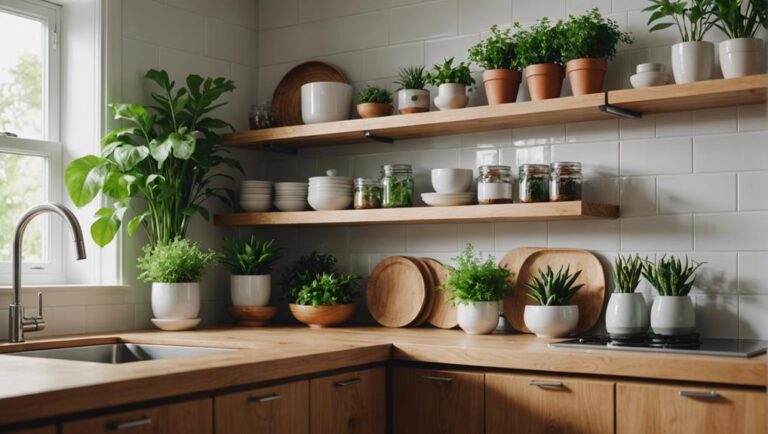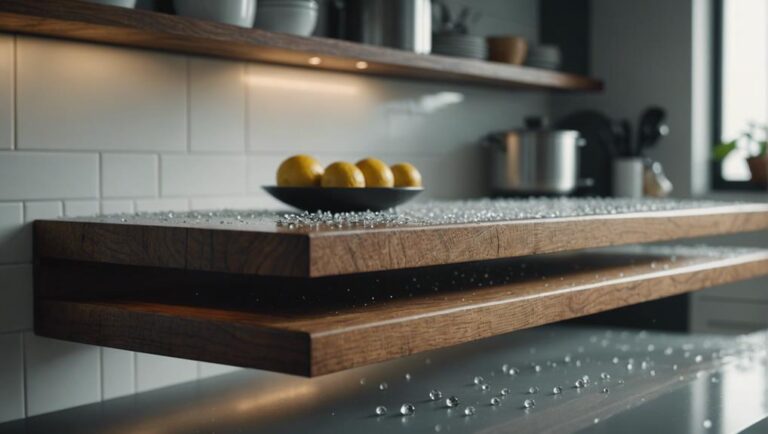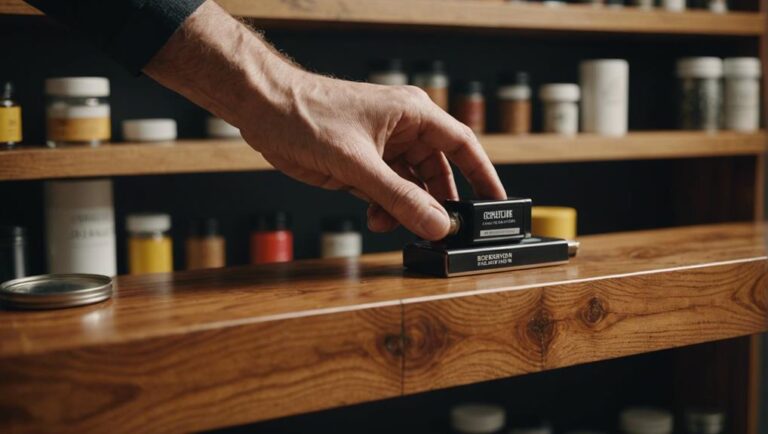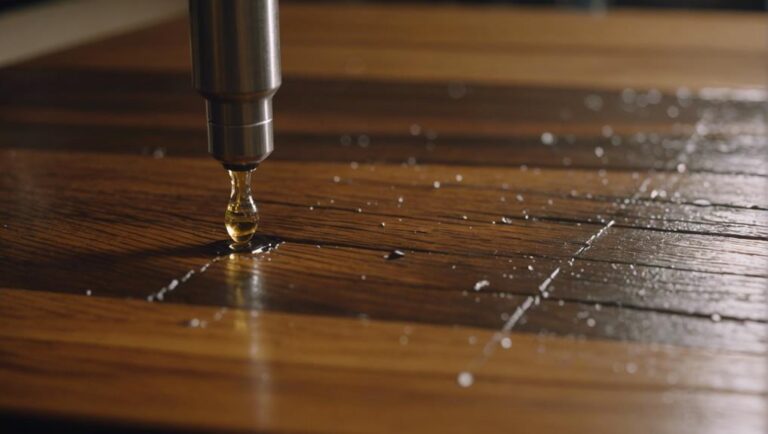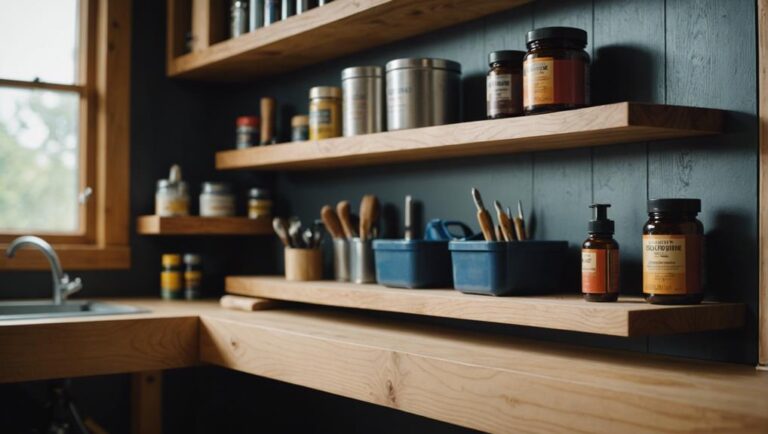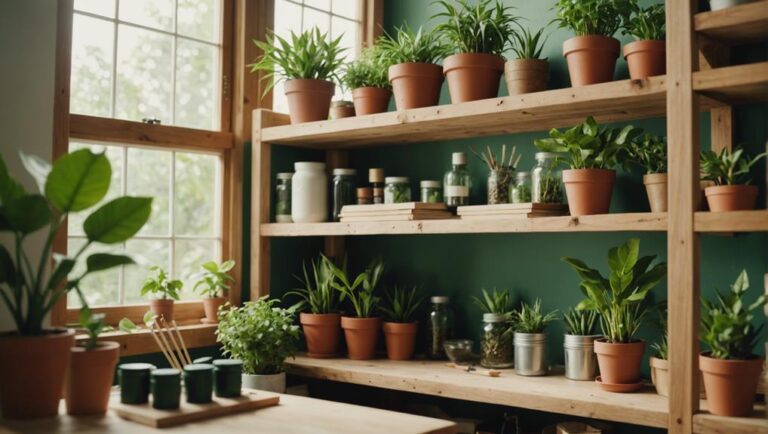Enhancing the Aesthetics of Floating Wood Shelves With Wood Sealants
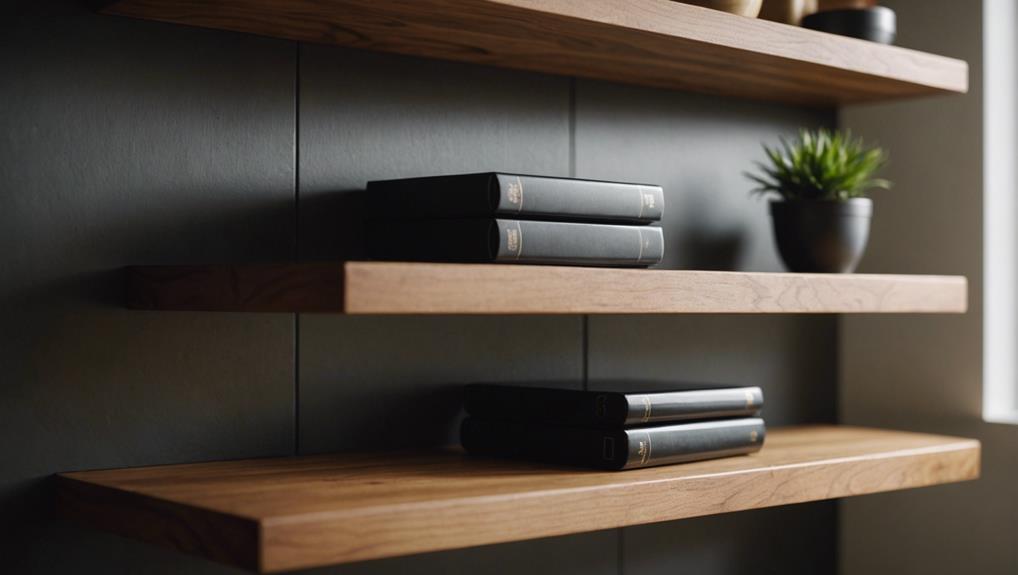
Enhancing the beauty of floating wood shelves with wood sealants starts by choosing the right sealant for your specific wood type and desired look. For softwoods, like pine or cedar, opt for a water-based polyurethane sealant. If you're working with hardwoods, such as oak or maple, an oil-based sealant might be more suitable.
Proper preparation is key to achieving a flawless finish. Begin by sanding the shelves with a fine grit sandpaper to create a smooth surface. After sanding, ensure to clean the shelves thoroughly to remove any dust or debris. It's crucial to allow the shelves to dry completely before applying the sealant.
When it comes to applying the sealant, remember that less is more. Use a suitable brush to apply thin coats of sealant, allowing each coat to dry completely before applying the next one. To achieve a professional finish, lightly sand the shelves between coats to remove any imperfections and create a smooth surface.
Choosing a high-quality sealant not only protects the wood from moisture and cracking but also enhances its natural grain and color. This helps to preserve the beauty and durability of the wood shelves for years to come.
By following these techniques and tips, you can elevate the aesthetics of your floating wood shelves and showcase the natural beauty of the wood.
Key Takeaways
When selecting sealants for your floating wood shelves, opt for products that enhance the natural wood grain and intensify its color, adding visual appeal to your space. Water-based polyurethane is an excellent choice for eco-friendly clear finishes on pine wood shelves, providing a protective coating without compromising the wood's natural beauty.
To achieve a professional finish, apply multiple thin coats of the sealant rather than one thick layer. This method ensures a smooth and even surface while allowing the wood to breathe and preventing any bubbling or cracking over time. Sanding between coats with 220-grit sandpaper is crucial for promoting adhesion and creating a seamless appearance.
Investing in high-quality brushes is essential to ensure an even application of the sealant on your floating wood shelves. Quality brushes will help you achieve a consistent finish without streaks or brush marks, enhancing the overall aesthetic appeal of your shelves.
Understanding Wood Sealants
Wood sealants are crucial for safeguarding and improving the durability of our floating timber shelves. These protective coatings are applied to timber surfaces to resist moisture, UV rays, scratches, and stains. By maintaining the natural elegance of our timber shelves, wood sealants play a key role in preserving both their utility and visual charm.
Various types of wood sealants like polyurethane, varnish, lacquer, and shellac offer distinct benefits and finishes. Each type provides its own advantages, from the sleek shine of lacquer to the sturdy protection of polyurethane. Whether opting for an oil-based or water-based sealant, understanding the characteristics of each can assist in making informed choices for the protection of our timber shelves.
Proper application of wood sealants can prevent common issues such as warping, cracking, and discoloration, ensuring that our floating timber shelves stay appealing and long-lasting. The decision between oil-based and water-based sealants also impacts drying times and application techniques, enabling customization based on individual needs and preferences. By prioritizing the use of top-notch wood sealants, we can significantly prolong the lifespan and allure of our floating timber shelves.
Selecting the Right Sealant
When choosing the appropriate sealant for our floating wood shelves, we must consider the wood type and the level of protection required, such as UV resistance, water resistance, or durability.
Water-based sealants are suitable for pine, while oil-based options are more appropriate for hardwoods. It's important to prioritize environmentally friendly sealants with low volatile organic compounds (VOCs) to ensure a safe and healthy indoor environment.
To maintain the integrity and longevity of our floating wood shelves, selecting the right sealant is crucial. The type of wood used in the shelves will determine the effectiveness of the sealant in providing protection against various elements.
Water-based sealants are known for their compatibility with pine wood, offering a reliable barrier against moisture and UV rays. On the other hand, hardwoods benefit from oil-based sealants, which provide enhanced durability and resistance to wear and tear.
Considering the environmental impact of the sealant is essential in promoting sustainability and indoor air quality. Opting for eco-friendly sealants with low VOCs not only safeguards the health of occupants but also contributes to reducing harmful emissions.
Types of Wood Sealants
Choosing the right sealant is essential for safeguarding our floating wood shelves against moisture, UV rays, and daily wear. Understanding the various types of wood sealants available empowers us to make informed decisions that can enhance both the longevity and visual appeal of our shelves.
Let's explore some popular options.
- Polyurethane: This versatile sealant offers a durable wood finish and comes in water-based and oil-based formulations. Ideal for high-traffic areas, polyurethane provides a sleek, contemporary appearance.
- Varnish: Renowned for its resilience, varnish can provide a glossy or matte finish, making it perfect for spaces like kitchens and bathrooms where shelves are regularly exposed to different elements.
- Oil-based finishes: Varieties such as tung oil or linseed oil deeply penetrate the wood, enriching its natural grain and color to impart a cozy, earthy ambiance to shelves.
- Shellac and lacquer: These fast-drying sealants yield a high-gloss finish, ideal for achieving a refined, professional look, although they may necessitate more maintenance in the long run.
Each type of sealant offers distinct advantages, catering to diverse aesthetic preferences and practical requirements. By selecting the appropriate sealant, we can ensure that our floating wood shelves not only exude beauty but also withstand the trials of time.
Application Best Practices
To choose the right sealant for our floating wood shelves, we must consider the type of wood and the desired finish to ensure both protection and aesthetics. Factors such as moisture resistance, UV protection, and scratch resistance play a crucial role in maintaining the pristine look of our shelves over time.
When selecting a sealant, it's important to match it with the specific type of wood being used. Hardwoods like oak may require a different sealant compared to softwoods like pine. Additionally, the chosen finish—whether matte, satin, or glossy—should align with our aesthetic preferences.
For a user-friendly application, water-based sealants are recommended due to their low odor, quick drying time, and ease of use.
Considering environmental and health factors is essential. Opting for non-toxic, eco-friendly sealants ensures that our living spaces remain safe and healthy. It's especially important to choose sealants that are safe for indoor use, as floating wood shelves are typically installed in high-traffic areas of our homes.
Preparing the Shelves
Properly preparing the shelves is crucial to ensure a smooth, long-lasting finish that enhances both the aesthetics and durability of your floating wood shelves. Let's begin by sanding the shelves. Sanding is essential for creating a surface that allows the wood sealant to adhere effectively, resulting in a seamless and refined appearance. It's best to use progressively finer grits of sandpaper to achieve optimal results.
After sanding, it's vital to thoroughly clean the shelves to remove any dust and debris. This step is crucial to ensure that the wood sealant bonds properly with the shelf surface, preventing any inconsistencies or rough spots.
In summary, follow these preparation steps:
- Sand the shelves: Begin with coarse sandpaper and gradually move to finer grit for a smooth finish.
- Clean thoroughly: Use a vacuum or a damp cloth to remove all dust and debris.
- Ensure uniform application: Use a brush or cloth to apply the wood sealant evenly.
- Allow for proper drying time: Adhere to the manufacturer's instructions for drying between coats.
Cleaning the Wood Surface
Now that the shelves are prepped, let's proceed with cleaning the wood surface to ensure the sealant sticks properly. It's crucial to have a clean surface, as any dust or debris left behind can affect the effectiveness of the sealant. We suggest using a mild soap and water solution for gentle yet efficient cleaning, keeping the wood undamaged.
When cleaning, it's important to be mindful of the cleaners we use:
| Recommended Cleaners | Cleaners to Avoid |
|---|---|
| Mild soap | Harsh chemicals |
| Water solution | Abrasive cleaners |
| Soft cloth | Rough scrubbing pads |
After cleaning, allow the wood surface to air dry completely before proceeding. Ensuring the surface is free of moisture is essential for a durable finish when applying the wood sealants. This step cannot be rushed; patience during this stage will result in a better final outcome.
Sanding the Shelves
Sanding the shelves plays a crucial role in ensuring a smooth and flawless surface for applying the wood sealant. By eliminating imperfections, rough spots, and splinters, we prepare the shelves for a seamless bond with the sealant. Employing fine-grit sandpaper is key to achieving this, as it effectively smoothens the surface without causing deep scratches, enhancing the overall look of our floating shelves.
To optimize the sanding process, it's essential to always follow the direction of the wood grain. This technique minimizes the risk of scratches and damage, preserving the wood's integrity.
Remember these important points:
- Select fine-grit sandpaper: This type of sandpaper is ideal for eliminating minor imperfections.
- Follow the wood grain: Sanding in this manner ensures a uniform and polished finish.
- Maintain consistent pressure: Even sanding pressure helps prevent uneven surfaces.
- Inspect thoroughly: After sanding, carefully check for any remaining rough areas.
Effective sanding isn't just about aesthetics—it's about creating a strong bond between the wood and the sealant, resulting in a professional and long-lasting finish. Paying attention to detail during this step sets the stage for a flawless application of the wood sealant, leading to stunning floating wood shelves.
Applying the First Coat
Now that we've sanded our floating wood shelves, it's time to apply the first coat of wood sealant.
Let's begin with preparing the surface to ensure a smooth application and discuss selecting the appropriate brushes for uniform coverage.
Get your tools ready and ensure your shelves are prepped for that flawless finish.
Surface Preparation Tips
Properly preparing the wood surface is crucial for achieving a smooth and long-lasting finish when applying the initial coat of wood sealant. Ensuring the shelf surface is clean, dry, and entirely free of dust or debris is essential.
Let's begin by addressing any larger imperfections by sanding them down with fine-grit sandpaper to create a smooth and even surface. This step is key in promoting better adhesion for the sealant and ultimately achieving a polished final appearance.
After sanding, it's imperative to thoroughly eliminate any remaining dust. A tack cloth is recommended for this task as it efficiently captures even the tiniest particles. Once the surface is clean, we can proceed with applying the first coat of wood sealant, following the manufacturer's guidelines regarding drying times and application methods.
To ensure we've covered all the necessary steps, let's run through a quick checklist:
- Confirm the wood surface is clean, dry, and free of debris.
- Lightly sand the wood surface to smooth out imperfections.
- Use a tack cloth to remove any lingering dust.
- Apply the first coat of wood sealant evenly, adhering to specified drying times.
Choosing Right Brushes
Choosing the right brush for applying the first coat of wood sealant plays a crucial role in achieving an even coverage and a smooth finish for our floating wood shelves. The brush size and quality are essential factors to consider when working on our project.
For oil-based wood sealants, opting for a high-quality natural bristle brush is ideal. This type of brush allows the sealant to flow smoothly and adhere effectively to the wood surface, enhancing the overall durability and aesthetic appeal of the shelves. On the other hand, when using water-based sealants, a synthetic brush is recommended due to its ability to minimize bristle absorption and ensure a more consistent application.
It is important to match the brush material with the type of wood sealant being used, as this decision directly impacts the final look and longevity of the floating wood shelves. Additionally, considering the size of the brush in relation to the scale of the project is essential.
For larger shelves, using a broader brush can help cover more surface area efficiently, reducing streaks and ensuring uniformity in the application. Conversely, when working on detailed or narrower shelves, a smaller brush size provides the precision and control necessary for achieving the desired results.
Investing in a quality brush for the first coat of wood sealant goes beyond immediate outcomes—it is a step towards enhancing the overall aesthetics and longevity of our floating wood shelves. By carefully selecting the right brush based on the type of sealant and the scale of the project, we can ensure a professional finish and long-lasting protection for our wooden shelves.
Letting the Coat Dry
To achieve a smooth and durable finish on your floating wood shelves, it's crucial to allow the wood sealant to dry completely between coats. Rushing this process can lead to issues like streaking, bubbling, or uneven coverage, ultimately affecting the overall quality of the shelves.
Drying times can vary depending on the type of wood sealant used, as well as the humidity and temperature conditions in the environment. Following the manufacturer's instructions closely is essential to ensure the best results. These guidelines are specifically designed to help you achieve the perfect finish you desire.
Patience during the drying process will ultimately result in a professional-looking and long-lasting finish. Proper drying is key for effective adhesion between each coat of sealant, ensuring a strong bond and a more durable finish.
Additionally, thorough drying enhances the shelf's resistance to wear and tear, increasing its longevity and protecting it from damage. Complete drying also plays a significant role in maintaining the appearance of the shelves, preventing unsightly marks and preserving a smooth surface texture.
Ultimately, allowing each coat to dry thoroughly helps build a robust finish that can withstand the test of time.
Sanding Between Coats
By sanding between coats, we ensure that our floating wood shelves are smooth and flawless, enhancing their overall appearance. Selecting the appropriate grit sandpaper is crucial to prevent any damage to the wood and to create a surface that promotes better adhesion for subsequent layers of protective coatings. Through meticulous surface preparation and the use of fine-grit sandpaper, our shelves will exude a refined and professional look.
In the realm of floating wood shelf materials, the choice of wood sealants and protective coatings plays a pivotal role in enhancing the durability and aesthetics of the shelves. By applying the right sealants, we can safeguard the wood against moisture, UV rays, and other environmental factors that may lead to deterioration. Additionally, protective coatings not only add a layer of defense but also contribute to the overall visual appeal of the shelves, creating a sleek and long-lasting finish.
Surface Preparation Tips
When aiming for a flawless finish on floating wood shelves, it's essential to lightly sand the surface with fine-grit sandpaper between each application of sealant. This step is crucial to eliminate any flaws, bubbles, or dust particles that may have gathered on the surface, ensuring a seamless and uniform appearance. The objective is to prepare the wood so that each subsequent layer of sealant bonds effectively, enhancing both the strength and visual appeal of the shelves.
Thorough sanding between coats promotes better adhesion and a professional outcome. Here are some key tips for preparing the surface:
- Dust Removal: After sanding, use a clean, damp cloth to wipe off all dust and debris.
- Inspection: Assess the surface for any lingering imperfections before proceeding with the next coat.
- Consistent Pressure: Maintain even sanding pressure to prevent uneven surfaces.
- Adhere to Drying Times: Allow each coat to fully dry according to the sealant's instructions before sanding.
Incorporating these practices will undoubtedly enhance the quality of our floating wood shelves.
Grit Selection Guide
Selecting the right grit sandpaper is crucial for achieving a smooth and professional finish when coating floating wood shelves. Understanding the significance of grit selection is key in ensuring the final outcome meets our standards.
To begin, we typically use lower grit sandpaper, ranging from 80 to 120, to eliminate any flaws and rough spots on the wood surface before applying the sealant.
As we progress to sanding between coats, opting for higher grit sandpaper in the 180-220 range is essential. This range helps us achieve a fine, polished surface without causing any harm to the wood. This step plays a vital role in refining the surface, enhancing the adhesion and penetration of the wood sealant, ultimately improving the shelves' durability and appearance.
For those seeking a flawlessly professional finish, gradually transitioning to even higher grit sandpaper, reaching up to 400, can significantly impact the end result. By meticulously selecting grits and employing precise sanding techniques, each coat of sealant can contribute to a long-lasting, aesthetically pleasing finish. By focusing on these details, we enhance the quality and longevity of our floating wood shelves.
Achieving Smooth Finishes
Now that we've chosen the correct 220-grit sandpaper, we can focus on achieving smooth finishes by sanding between coats of wood sealants on our floating wood shelves. This critical step helps to eliminate imperfections, rough spots, and brush marks, ensuring that the subsequent coats adhere well to the wood surface. This not only results in a professional-looking finish but also enhances its durability.
To achieve optimal results:
- Use a 220-grit sandpaper: This fine-grit option is perfect for gently smoothing the sealant without causing any damage to the wood.
- Lightly sand the surface: Apply minimal pressure to avoid removing too much of the sealant layer; the goal is to achieve smoothness, not to strip it off.
- Clean the surface: After sanding, use a tack cloth to wipe down the shelves and remove all dust and debris, creating a clean surface for the next coat.
- Apply multiple coats: Sanding between each coat helps to build up a flawless finish, showcasing the natural beauty of the wood and increasing the durability of the sealant.
Applying Additional Coats
Applying extra layers of wood sealant not only enhances the beauty of floating wood shelves but also significantly improves their protection and durability. Each added coat of wood sealant not only enriches the appearance of the shelves but also reinforces them against moisture, stains, and scratches. This results in shelves that not only look stunning but also remain in top condition for a longer period.
Every additional coat of sealant adds depth to the shelves, highlighting the natural color and grain of the wood and creating a visual masterpiece. However, the benefits of multiple coats extend beyond aesthetics. They also significantly enhance the durability and lifespan of our floating wood shelves, ensuring they can withstand daily use and maintain their beauty over time.
To achieve a smooth and consistent finish without streaks or bubbles, it's crucial to adhere to the manufacturer's instructions regarding drying times between coats. Proper application is essential – rushing through this process can result in imperfections that compromise both the visual appeal and protective qualities of the sealant.
For those who appreciate the fusion of beauty and innovation, applying additional coats of wood sealant is a transformative practice. It's a straightforward yet effective method to elevate the appearance and safeguard the longevity of our floating wood shelves.
Choosing a Finish
When it comes to choosing the right finish for our floating wood shelves, it's crucial to consider both aesthetics and functionality to ensure their long-term beauty and durability. Different wood sealants offer unique benefits, so it's important to weigh the options carefully.
Polyurethane sealants come in glossy or matte finishes and provide a tough protective layer against scratches and moisture. This makes them ideal for areas that experience high traffic or potential water exposure, such as kitchens or bathrooms.
Oil-based sealants penetrate deeply into the wood, enhancing its natural grain and offering a rich, warm finish. However, they do take longer to dry and have a stronger odor, so they may be more suitable for well-ventilated spaces.
Water-based sealants dry quickly, have a low odor, and maintain the wood's original color with a clear finish. These are perfect for indoor shelves where a quick application and minimal smell are priorities.
When considering the location and usage of our floating wood shelves, it's important to choose a sealant that can withstand the specific demands of the environment. By selecting the right finish, we can ensure that our shelves not only look stunning but also remain protected and resilient over time.
Enhancing Wood Grain
To truly emphasize the natural beauty of our floating wood shelves, we can utilize sealants that enhance and safeguard the wood grain. Wood sealants play a crucial role in showcasing the intricate patterns and textures that are unique to each piece of wood. By applying a high-quality sealant, we not only intensify the wood's color, bringing out deep tones and adding a sense of depth to the surface, but also ensure its long-lasting durability.
Various types of sealants—such as oils, waxes, and polyurethanes—offer different levels of sheen and protection. Oils can deeply penetrate the wood, highlighting the grain and providing a warm, rich color. Waxes introduce a soft sheen, ideal for a more subtle finish, while polyurethanes deliver robust protection against wear and tear, effectively accentuating the wood grain.
Properly sealing our shelves makes them easier to clean and maintain, preserving the integrity of the grain for years to come. This not only enhances the visual appeal of our shelves but also maintains their top condition, reflecting our innovative approach to home décor.
Protecting Against Moisture
Protecting our floating wood shelves from moisture is crucial, and a high-quality sealant serves as our primary defense. Wood sealants form a strong barrier against moisture, ensuring our shelves remain sturdy and attractive. By using sealants such as polyurethane or lacquer, we can shield our shelves from the humidity and spills typically found in kitchens or bathrooms.
Moisture protection is essential for our floating wood shelves for several reasons:
- Preventing Damage: Wood sealants prevent warping, swelling, and other moisture-related damage, preserving the structural integrity of our shelves.
- Fighting Mold and Mildew: Proper sealing makes our shelves resistant to mold, mildew, and rot, which can significantly degrade wood over time.
- Enhancing Longevity: By maintaining their aesthetics and structure, sealed shelves have a longer lifespan, providing us with more value and reducing the need for frequent replacements.
- Regular Maintenance: Regular application of wood sealants ensures ongoing protection, making our shelves durable and reliable in high-moisture environments.
Using advanced moisture protection techniques allows us to enjoy the natural beauty of wood while ensuring it can withstand daily challenges. Let's embrace the technology behind wood sealants to keep our floating shelves in top condition and well-protected.
Preventing Cracks and Warping
To prevent cracks and warping in our floating wood shelves, we need to focus on using the right wood sealants and protective coatings that are specifically designed for the type of wood we're using. These sealants create a barrier against moisture and humidity, which can compromise the integrity of the wood over time. By choosing high-quality sealants and applying them correctly, we can effectively protect our shelves from environmental damage.
Regular maintenance is also crucial in ensuring the longevity of our floating wood shelves. This includes periodically reapplying the sealant to maintain its effectiveness in blocking moisture and preventing warping. By staying proactive in our maintenance routine, we can keep our shelves looking beautiful and structurally sound for years to come.
Moisture Control Techniques
Choosing the right wood sealant plays a vital role in safeguarding floating shelves against moisture infiltration and preserving their integrity. Understanding the significance of moisture control techniques is key to maintaining the quality of your shelves.
Keeping your shelves clean is essential to ensure the sealant's effectiveness. Regular dusting and gentle cleaning help maintain the protective barrier of the sealant, keeping your shelves in top condition.
Applying a wood stain before sealing provides an additional layer of defense. Not only does the stain enhance the natural beauty of the wood, but it also acts as a preliminary shield against moisture.
Consider these innovative moisture control strategies:
- Opt for a top-quality sealant: Investing in a high-grade product ensures superior protection against humidity and water damage.
- Regularly reapply the sealant: Consistent reapplication strengthens the wood's resilience to environmental elements.
- Monitor indoor humidity levels: Using a dehumidifier can help reduce moisture in the air, safeguarding the wood from potential damage.
- Inspect for any signs of damage: Regularly checking for cracks or warping enables prompt repairs, prolonging the shelf's longevity.
Sealant Application Tips
When sealing floating wood shelves, it's essential to choose the correct sealant that matches the type of wood and desired finish. This selection will create a strong barrier against moisture, UV rays, and temperature changes, which can cause damage to the wood over time.
Before applying the sealant, ensure that the wood surface is clean and dry. Any remaining moisture can become trapped under the sealant, leading to potential issues in the future. Lightly sanding the shelves before sealing helps the sealant adhere better, improving its effectiveness in protecting the wood.
For application, use a high-quality brush or applicator to achieve an even coat. Make sure to cover all sides of the floating shelves, including the edges and underside, for complete protection.
It's recommended to apply multiple thin coats rather than one thick layer. Allow each coat to dry completely before proceeding to the next one. This approach not only enhances the visual appeal of the wood but also provides superior protection against environmental elements.
Long-term Maintenance Strategies
To maintain our floating wood shelves effectively, it's crucial to employ long-term care strategies that prevent cracks and warping. Ensuring the durability and visual appeal of our shelves is key.
Here are some essential steps to follow:
- Regular Inspections: It's important to routinely check the shelves for any signs of damage or wear. This proactive approach allows us to address issues early on, making long-term maintenance easier.
- Reapplication of Sealants: Over time, wood sealants can degrade, especially in environments with high humidity levels. Reapplying sealants as necessary ensures continuous protection against moisture and temperature variations.
- Environment Control: Maintaining a stable indoor environment is crucial for the longevity of the shelves. Using dehumidifiers or air conditioners can help regulate humidity levels, reducing the risk of wood warping.
- Quality Sealants: Investing in high-quality wood sealants from the beginning offers superior protection and longevity, prolonging the lifespan of our shelves.
Maintaining the Sealant
To ensure the durability of the sealant on our floating wood shelves, it's crucial to conduct regular inspections for any signs of wear or damage. This proactive approach enables us to address potential issues before they worsen.
Cleaning the shelves with a mild soap and water solution helps maintain the sealant, but for optimal results, utilizing a wood-specific cleaner is recommended. This not only sustains the effectiveness of the sealant but also preserves the quality of the wood.
Key maintenance tasks for the floating wood shelves include monthly inspections for damage, bi-weekly cleaning with mild soap, monthly use of a wood-specific cleaner, reapplication of the sealant as needed (typically annually), and rotating displayed items every few months.
Reapplying the sealant when necessary is essential to safeguard the wood from moisture and wear. Moreover, rotating the items on the shelves periodically helps prevent uneven wear on the sealant, thus prolonging its lifespan.
Eco-Friendly Sealant Options
Exploring eco-friendly sealant options helps us protect our floating wood shelves while minimizing harm to the environment. These sealants, crafted from natural ingredients, not only shield our shelves from moisture, UV rays, and wear but also ensure we're not introducing harmful chemicals into our living spaces.
For those of us with shelves in a kitchen, using non-toxic and safe sealants is crucial. Eco-friendly sealants provide numerous benefits:
- Natural ingredients: They reduce environmental impact.
- Water-based formulas: They make application and cleanup simple.
- Non-toxic: Safe for indoor use, promoting healthier indoor air quality.
- Sustainable living: Aligns with eco-conscious practices.
Selecting eco-friendly sealants showcases our dedication to innovation and sustainability. These sealants are especially beneficial for kitchen shelves, where food and utensils are stored, ensuring a safer environment. The non-toxic quality of these products allows us to confidently use them in spaces where our families spend a lot of time.
Furthermore, water-based sealants streamline the application process, making our project more efficient and enjoyable. Embracing eco-friendly sealants not only safeguards our stunning floating wood shelves but also supports our aim of creating a healthier, more sustainable home.
This forward-thinking approach enhances both the aesthetics and functionality of our living spaces.
Frequently Asked Questions
How Do You Make Floating Shelves Look Good?
To enhance the appearance of floating shelves, it is crucial to select high-quality wood materials that complement your existing decor. Opt for durable wood species like oak, walnut, or cherry, which not only add warmth and character to your space but also offer longevity. These wood materials can be further enhanced with sealants and protective coatings to ensure they maintain their beauty and functionality over time.
When choosing a sealant or protective coating for your floating shelves, consider options like polyurethane, lacquer, or varnish. These coatings not only provide a protective barrier against moisture, scratches, and stains but also enhance the natural beauty of the wood grain. By sealing your shelves with the right finish, you can elevate their visual appeal and ensure they withstand daily wear and tear.
Incorporating floating shelves into your decor can be a creative way to showcase your personal style and add functionality to your space. Experiment with different placement options, such as staggering shelves at varying heights or creating asymmetrical arrangements to create visual interest. By aligning your floating shelves with your decor style and exploring unique placement ideas, you can ensure they not only serve a practical purpose but also enhance the overall aesthetic of your room.
Should You Seal Wood Shelves?
Sealing wood shelves is a crucial step in ensuring their longevity and protection. By applying a sealant, you enhance the durability of the shelves and provide a barrier against moisture damage, keeping them in pristine condition for longer periods. While some may prefer the natural look of wood, modern sealants can elevate the aesthetics of the shelves without compromising their functionality.
Wood sealants come in various forms, such as polyurethane, varnish, or lacquer, each offering unique benefits for protecting wood surfaces. Polyurethane sealants, for example, provide a strong protective layer that resists scratches and stains, making them ideal for high-traffic areas. Varnish sealants offer a glossy finish that enhances the natural beauty of the wood, while lacquer sealants provide a durable and quick-drying option for efficient protection.
Incorporating a wood sealant into your maintenance routine for wood shelves is a simple yet effective way to prolong their lifespan and keep them looking their best. Whether you choose a polyurethane, varnish, or lacquer sealant, the added protection they provide will ensure that your wood shelves remain sturdy and visually appealing for years to come.
Should You Caulk Floating Shelves?
Caulking floating shelves is essential for filling gaps and providing moisture protection. This process enhances the shelf's stability and durability by preventing dust accumulation and potential water damage. By applying a quality sealant, we can achieve a seamless and polished look for our shelves, ensuring they remain in top condition for a long time.
Using a reliable sealant on floating shelves is a smart approach to maintaining their integrity and appearance. Properly caulking the edges and joints of the shelves will not only improve their aesthetic appeal but also contribute to their long-term functionality. This step is crucial in ensuring that the shelves are well-protected against moisture and other environmental factors that could compromise their quality.
How Do You Finish Wood Floating Shelves?
Did you know that 85% of DIY enthusiasts prefer using wood sealants and protective coatings for a personalized touch on their floating wood shelves? Starting with advanced sanding techniques to ensure a smooth surface, the next step involves applying a carefully chosen wood sealant or protective coating to enhance the durability and appearance of the innovative floating wood shelves.
Wood sealants and protective coatings not only add a personalized touch but also provide essential protection against moisture, UV rays, and everyday wear and tear. By selecting the right sealant or protective coating for your floating wood shelves, you can enhance their longevity and maintain their aesthetic appeal for years to come.
When it comes to finishing wood floating shelves, the use of wood sealants and protective coatings is a popular choice among DIY enthusiasts. By following proper techniques and selecting the right products, you can achieve a personalized and durable finish that enhances the beauty of your floating wood shelves.
Conclusion
Let's elevate the beauty of floating wood shelves by carefully selecting the perfect wood sealant. Imagine the luxurious warmth of well-protected wood, free from imperfections like cracks and warping, standing strong against moisture.
To achieve this, we must follow a simple process of cleaning, sanding, and sealing. This approach ensures not only durability but also enhances the visual appeal of our wooden shelves.
Maintaining the sealant may seem like a minor task, but it plays a crucial role in preserving both the aesthetic allure and the structural integrity of our beloved wooden shelves. With the right sealant, we can ensure that our floating wood shelves remain a stunning focal point in our living spaces, adding a touch of elegance and charm.

